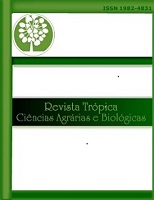MIMOSOID CLADE (CAESALPINIOIDEAE, FABACEAE) IN THE OLHO D’ÁGUA DAS ONÇAS ECOLOGICAL RESERVE, PICUÍ, SERIDÓ OF PARAÍBA STATE, BRAZILIAN NORTHEAST
Keywords:
Fabales, Mimosa, semiaridAbstract
Fabaceae is the most diversified angiosperm family of the Caatinga. Mimosoid clade is comprised in the Caesalpinioideae subfamily, is Pantropical, occurring in both dry and humid regions, and is relevant from a taxonomic point of view in the Caatinga phytogeographic domain. This study aimed to present the list of species of Mimosoid clade in the Olho d’Água das Onças Ecological Reserve, a Conservation area of Caatinga located in the municipality of Picuí, Seridó of Paraíba, Brazilian Northeast. We have done 11 field expeditions between August/2022 and April/2023, following traditional collection and herborization methods for taxonomic studies. Species identification was based on specialized literature and the geographic distribution data were obtained from the Flora e Funga do Brasil online platform. In the studied area, we found seven species, in three genera: Chloroleucon (1 sp.), Mimosa (5 spp.) and Pityrocarpa (1 sp.), one of these is endemic of the Caatinga domain (Pityrocarpa moniliformes) and another is endemic to the Northeast region (Mimosa paraibana). We present here the species list, with their respective types of habits, geographic distribution, frequency, flowering and or fruiting data. Based on the results, the Olho d’Água das Onças ER constitutes an important center of floristic diversity in the Brazilian Northeast.
Downloads
References
APG IV. An update of the Angiosperm Phylogeny Group classification for the orders and families of flowering plants: APG IV. Botanical Journal of the Linnean Society, London, v. 181, n. 1, p. 1-20, abr. 2016. Disponível em: https://academic.oup.com/botlinnean/article/181/1/1/2416499. Acesso em: 26 mai. 2023.
FLORA E FUNGA DO BRASIL (continuamente atualizada). Jardim Botânico do Rio de Janeiro. Disponível em: http://floradobrasil.jbrj.gov.br/. Acesso em: 16 jun. 2023.
FRANCISCO, P. R. M.; MEDEIROS, R, M.; SANTOS, D.; MATOS, R. M. Classificação Climática de Köppen e Thornthwaite para o Estado da Paraíba. Revista Brasileira de Geografia Física, v. 8, n. 4, p. 1006-1016, 2015. Disponível em: https://periodicos.ufpe.br/revistas/rbgfe/article/view/233503. Acesso em: 7 jun. 2023.
FRANCISCO, P. R. M.; PEREIRA, F. C.; MEDEIROS, R. M.; SÁ, T. F. F. Zoneamento de risco climático e aptidão de cultivo para o município de Picuí – PB. Revista Brasileira de Geografia Física, v. 4, n. 5, p. 1043-1055, 2011. Disponível em: https://periodicos.ufpe.br/revistas/rbgfe/article/view/232756. Acesso em: 7 jun. 2023.
FREIRE-JÚNIOR, J. M. S.; SILVA, J. S. Clado Mimosoide (Leguminosae Caesalpinioideae) no Parque Estadual da Serra dos Montes Altos, Bahia, Brasil. Rodriguésia, v. 70, e04162017, 2019. Disponível em: https://www.scielo.br/j/rod/a/BFKjxt85hJ5hXtTZg3w3TNc/. Acesso em: 26 mai. 2023.
GOMES, G. S.; CAMELO-JÚNIOR, A. E.; VELOZO, C. O.; SILVA, G. S.; CONCEIÇÃO, G. M. FLORÍSTICA E TAXONOMIA DO CLADO MIMOSOIDE (FABACEAE, CAESALPINIOIDEAE) NO MUNICÍPIO DE SÃO JOÃO DO SÓTER, MARANHÃO, BRASIL. Agrarian Academy, Centro Científico Conhecer - Goiânia, v. 4, n. 8, p. 153-165, 2017. Disponível em: https://conhecer.org.br/ojs/index.php/agrarian/article/view/5092. Acesso em: 26 mai. 2023.
IBGE – INSTITUTO BRASILEIRO DE GEOGRAFIA E ESTATÍSTICA. Biomas e sistema costeiro-marinho do Brasil: compatível com a escala 1:250 000/IBGE, Coordenação de Recursos Naturais e Estudos Ambientais. Rio de Janeiro: IBGE, 2019.
IBGE – INSTITUTO BRASILEIRO DE GEOGRAFIA E ESTATÍSTICA. Divisão Territorial Brasileira – DTB 2021. Rio de Janeiro: IBGE, 2021.
LPWG - The Legume Phylogeny Working Group. A new subfamily classification of the Leguminosae based on a taxonomically comprehensive phylogeny. Taxon, v. 66, n. 1, p. 44-77, fev. 2017. Disponível em: https://onlinelibrary.wiley.com/doi/abs/10.12705/661.3. Acesso em: 26 mai. 2023.
MATOS, S. S.; MELO, A. L.; SANTOS-SILVA, J. Clado Mimosoide (Leguminosae-Caesalpinioideae) no Parque Estadual Mata da Pimenteira, Semiárido de Pernambuco, Brasil. Rodriguésia, v. 70, e01902017, 2019. Disponível em: https://www.scielo.br/j/rod/a/cDwWJwJjwWvMSsyCWCHJX9J/abstract/?lang=pt. Acesso em: 26 mai. 2023.
PEIXOTO, A. L.; MAIA, L. C. Manual de Procedimento para Herbários. Recife: Editora Universitária UFPE, 2013.
QUEIROZ, L. P. Leguminosas da Caatinga. Feira de Santana: Universidade Estadual de Feira de Santana, 2009.
QUEIROZ, R. T. Fabaceae do Cariri Paraibano. Nova Xavantina, MT: Pantanal, 2021.
SILVA, J. S. Roteiro turístico geoeducativo na Reserva Ecológica Olho d’Água das Onças. 2021. 57f. (Trabalho de Conclusão de Curso – Monografia), Curso de Licenciatura em Geografia, Centro de Humanidades, Universidade Federal de Campina Grande – Campina Grande – Paraíba – Brasil, 2021.
Downloads
Published
How to Cite
Issue
Section
License

This work is licensed under a Creative Commons Attribution-NonCommercial-NoDerivatives 4.0 International License.
Direitos autorais Revista Trópica: Ciências Agrárias e Biológicas
Este obra está licenciado com uma Licença Creative Commons Atribuição-NãoComercial-SemDerivações 4.0 Internacional.








